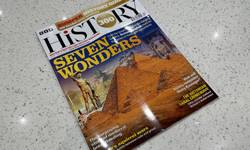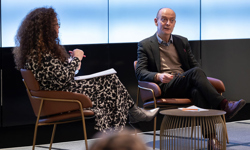PRIVATE EYE
What’s it about: 'The UK's best selling news and current affairs magazine…' – blurb on website. Accurate, if rather understated.
Vital statistics: Published fortnightly. October 16-29 issue: 48 pages of 297mm x 209mm. Newsprint, self cover, stitched. £1.80 cover price. Jan-June 2015 combined ABC of 228,264, no digital. Published by Pressdram Ltd in London.
Cover: One headline over bubble caption pictures with subheads. Masthead, armoured knight cartoon logo, date, price. That's it.
Content: New readers from Mars might be bemused by the mix of hard news, cartoons, parody, readers’ contributions and investigations but the Private Eye faithful love it. Sales continue to rise despite (or maybe because of) a rather prosaic design and elements that have not changed for many years. Witty, funny, acerbic, insightful and containing some of the sort of investigative journalism that national newspapers used to do.
Digital: “We have explored digital in great depth, but it doesn’t actually work,” Sheila Molnar, the magazine’s managing director, told the Financial Times. “We can’t find something that replicates the look and feel of Private Eye. Also, I’ve never known anyone who has been able to monetise it." Still has a neat website, plus 339,000 Twitter followers and 160,000 likes on Facebook.
What they say: “The commercial model [of Private Eye] is fantastic. They are pioneers in doing nothing,” Fraser Nelson, editor of the Spectator.
Verdict: Still filling the satirical gap left by Punch (RIP 2002) and publishing where others won't be damned. Now that serious hard-hitting journalism as previously practised by national newspapers is beset by commercial and political pressures, Private Eye continues to find a market and more readers. Editor Ian Hislop (HIGNFY and other telly appearances) is the well-known face of Eye while other journalists stay out of the limelight, with not a byline in sight.
THE ECONOMIST
What’s it about: 'Published since September 1843 to take part in "a severe contest between intelligence, which presses forward, and an unworthy, timid ignorance obstructing our progress"' – from blurb on contents page.
Vital statistics: Published weekly. October 10-16 issue: 96 pages of 267mm x 203mm. Thin gloss paper, heavier cover, stitched. £5.00 cover price. Combined ABC of 227,914, a whopping 70,953 (32 per cent) from digital. Published by The Economist Newspaper Ltd in London.
Cover: Clever photo illustration of a mosquito pierced by an arrow, five well-crafted coverlines plus furniture and that hefty £5.00 price lurking above the barcode.
Content: Lots in it. A relatively small typeface and use of a two-column grid in the comment section makes it feel that readers are getting their money's worth. Has a distinct international approach which is well signposted, plus serious insights into serious topics - business, finance, science - and just three pages of playtime with books and arts.
Digital: Has consistently led the way with an innovative approach to both sales and engagement, reflected by its hefty digital sales. With nearly 11 million Twitter followers and nearly six million Facebook likes, it is one of the most followed multimedia publications in the world.
What they say: "The surveillance-based business model of online advertising is simply annoying a lot of people,” deputy editor Tom Standage at the Association of Online Publishers’ autumn conference.
Verdict: The Economist’s Espresso app, which has been downloaded almost a million times since it launched a year ago, reaches around 100,000 people every day. And that's about all you need to know about the Economist: dynamic, forward-thinking and positioning itself as a truly international multimedia brand.
THE WEEK
What’s it about: Take your pick: 'The best of British and international media' tagline and 'All you need to know about everything that matters' propping up the cover.
Vital statistics: Published weekly. October 10 issue: 64 pages of 297mm x 210mm. Gloss paper, self cover, stitched. £3.10 cover price. Combined ABC of 202,842, none from digital. Also separate ABC Digital Publication report showing 30,750. Published by Dennis in London.
Cover: Almost full-page illustration (Putin and Assad), three thumbnail pictures (gas mask, Trump, chair), four coverlines and that big white-on-red masthead.
Content: Neat use of small pictures and graphics helps the readability. Nothing is more than half a page and a lot of stuff is contained in half a paragraph. News goes up to page 26, followed by letters which are in fact letters to other publications, and arts. Two pages of posh properties, food and drink, travel, finance and all wrapped up with a book extract.
Digital: Newsy website plugged from the front page. A miserable 8,630 Twitter followers (0.00863 per cent of the Economist's) and 60,000 Facebook likes, but obvious effort made to engage and enthuse.
What they say: "The Week incorporates The First Post. The Week™ and The First Post™ are trademarks of Felix Dennis" – hands-off warning on website.
Verdict: A cute concept that feels like a printed version of Google news. A must for pub quizzers and anyone wanting to sound knowledgeable and up-to-the-minute without having to put in the hard licks of reading one of the other publications reviewed here. But 34 consecutive circulation increases since launch tell their own story.
THE SPECTATOR
What’s it about: 'The oldest continuously published magazine in the English language' – embedded on website.
Vital statistics: Published weekly. October 10 issue: 72 pages of 278mm x 213mm. Gloss paper, heavier cover, stitched. £4.00 cover price. Combined ABC of 55,669, none from digital. Published by The Spectator (1828) Ltd in London.
Cover: Political cartoon (Putin, Cameron, Obama) and nine coverlines, all with named writers. Range of typography from a rather poorly kerned serif lead headline to tight condensed sans cross-refs. And two questions in headlines is two too many.
Content: The Week, Books & Arts, Life… Drink, Your problems solved - what more could you wish for from your weekly magazine? A wide range of topics from intelligent writers, plus Rod Liddle. Displayed in a spare design with small headlines, neat byline caricatures and interspersed with cartoons and even a poem. And, of course, there's High Life by Taki, a fixture for nearly 40 years.
Digital: Busy website dominated by ads right, left and above (for Heathrow in mid-October). No links to social media from the website but they are there: nearly 70,000 Twitter followers and 85,000 Facebook likes.
What they say: "Lord Leveson’s legacy could be the death of investigative journalism," – headline on Coffee House blog post. "Even better than the word 'manège' are all the property adverts that sell houses complete with 'menage's," Camilla Swift, who does the Spectator tweets, writing about, er, something.
Verdict: When you've been around for 187 years, some people may think you're rather past it. But not a bit of it. Intelligent, engaging, well written and with all the youthful energy of a new publication.
PROSPECT
What’s it about: 'The leading magazine of ideas' – tagline on website masthead (but not magazine).
Vital statistics: Published monthly. October issue: 90 pages of 276mm x 210mm. Gloss paper, heavyweight cover, perfect bound. £4.95 cover price. Combined ABC of 31,425, 1,534 from digital. Published by Prospect Publishing Limited in London.
Cover: Seven coverlines and 13 named writers including Andrew Marr, Clive James, Andrew Adonis and Bronwen Maddox (aka The Editor and Chief Executive). A cartoonish illustration and two cross-refs, one with obligatory cupcake.
Content: Opinions, features, arts & books all presented in a rather formal two and three-column format - sometimes confusingly on the same page. Pocket cartoons add a bright touch along with some natty graphics and illustrations. Longish reads that take some concentration and they do love those big name bylines (AC Grayling, Chris Huhne, Peter Kellner et al from above) - even the puzzle compiler gets a name check.
Digital: Fresh website with a modern appeal. Nearly 30,000 Twitter followers who are treated to some cut and thrust with other commentators, and 13,000 Facebook likes. Enticing offer of 'free e-book' when you sign up for 'free newsletter'.
What they say: "The one thing a leader has to do is deliver a decent speech once a year, that was a rag bag of clichés with no evidence of a political brain," – tweet from editor-at-large David Goodhart about Jeremy Corbyn's conference speech.
Verdict: The magazine's website boasts that 'People turn to Prospect for the ideas and trends behind the headlines and for a contrarian view of topics'. With so many writers for hire on show, it's difficult to assess how contrary they are, but there is definitely a 'something for everyone' appeal, if that's how you take your tea.
NEW STATESMAN
What’s it about: 'Free thinking since 1913' – tagline on cover.
Vital statistics: Published weekly. October 9-15 issue: 72 pages of 275mm x 210mm. Matt paper, self cover, stitched. £3.95 cover price. Combined ABC of 29,353, 493 from digital (January to December 2014). Published by New Statesman in London.
Cover: Oddly cropped illustration (what's happened to Putin's left arm?), seven coverlines featuring nine writers all set against a plain white background making it readable - and visible on the newsagent's shelf.
Content: Newsy columns and what they call 'Observations'. Five long reads (three of them about Putin and Syria) and a generous 'Critics' section with books, film, TV etc. All set out in a very orderly fashion helped by big pictures, small headlines and an affection for white space. The use of a four column grid at the front and the back of the book gives an added gravitas to the three-column heavyweights in the middle.
Digital: Clean, modern website augmented by The Staggers rolling politics blog. An engaging 115,000 Twitter followers and 109,000 Facebook likes despite no obvious click-through from the website and no promotion in print.
What they say: "Very belatedly I've joined Twitter, under pressure from the NS team…" – tweet from editor Jason Cowley (on April 30). "The right person will have omnivorous reading habits and the ability to assimilate new topics at speed… you must be willing to take direction and get involved with unglamorous tasks," – job ad for editorial assistant at New Statesman.
Verdict: Doesn't wear its left wing credentials quite as obviously as irregular readers might suppose and comes across as thoughtful and thought-provoking. A well-rounded offer if you've got the time to read even a fraction of it.












